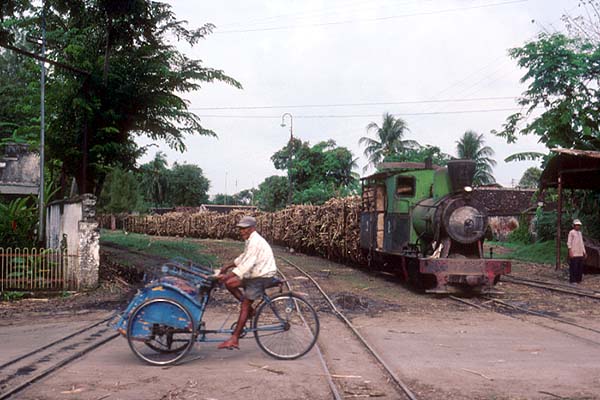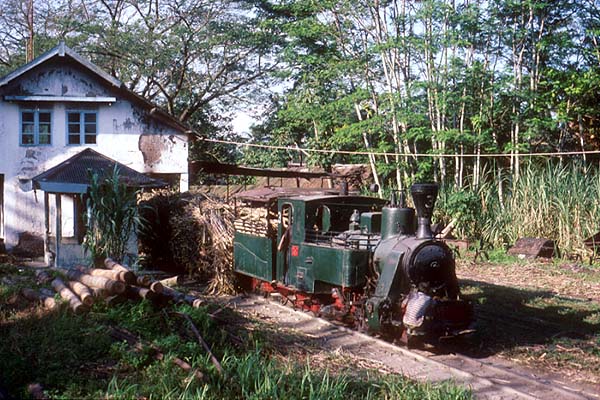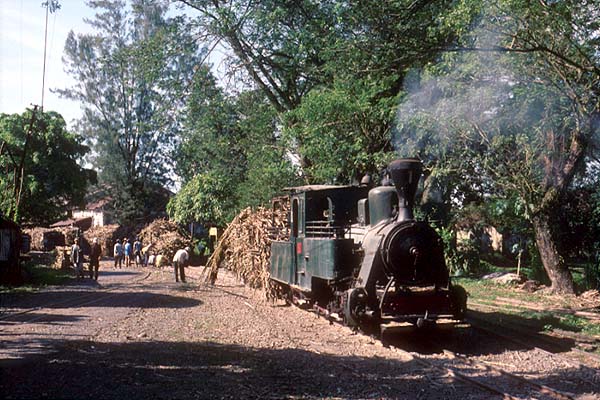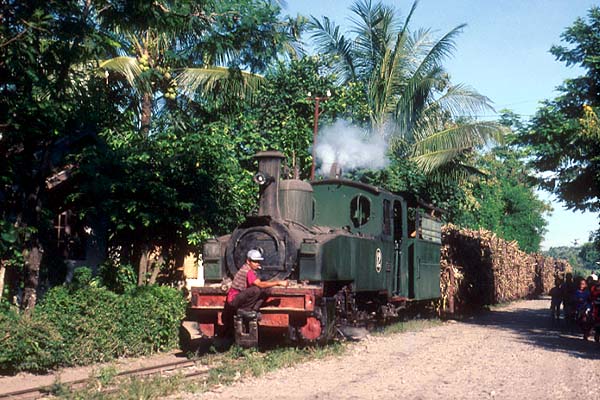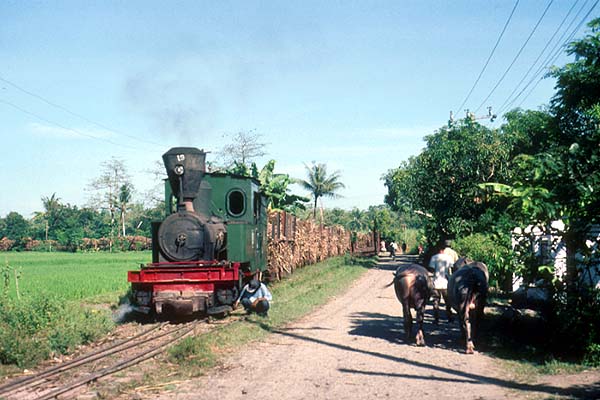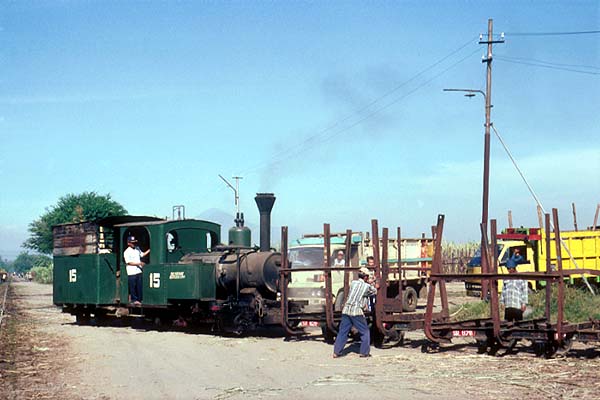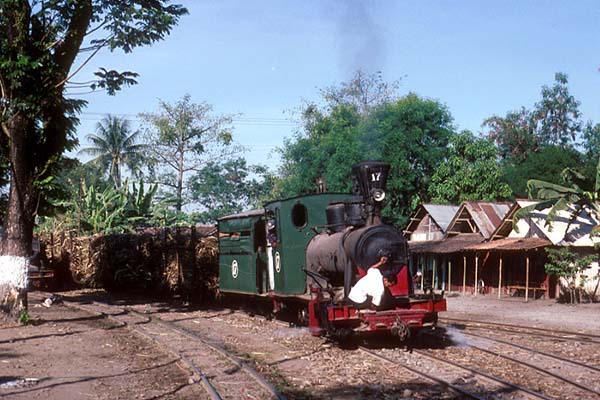|
Java Sugar Steam 2001 - Central Java North Coast |
|
|
These mills were operated originally by PNP XV which became part of PNP XV/XVI, subsequently PTP XV/XVI which is now known as PTP Nusantara IX. They have a large number of steam locos, most operating to the fields in the traditional manner but they have the universal attribute of doing most of their most interesting work during the hours of darkness - presumably to balance the road deliveries which tend to be made during the day time. In 1998/9/2000, the mills charged a uniform RP 25000 per visitor. Future prospects are obviously not good here, in 2000 the position had stabilised, and in 2001 there was a definite (surprising) improvement. On the dark side it appears beer has been banned from sale in Pekalongan, I had to import some from elsewhere. 7. BANJARATMA Mill Index This mill closed at the end of the 1997 season.. Two of its diesel locomotives have gone to Tasik Madu, the steam locomotives are stored and being of 750mm gauge are unlikely to find use elsewhere - the only remaining working mill with this gauge is Tasik Madu and this has more than enough locos for the traffic on offer. The estate still grows sugar as part of the Jatibarang administered area, but virtually all the track has been lifted and the cane goes out by truck. 8. JATIBARANG Mill Index With a new Japanese diesel from Cepiring, steam activity in 1999 was at a low ebb. In 2000, they took delivery of the other one with the inevitable consequences. The mill was reported by Steve Noon to have started in mid-May and to have been pretty busy soon after. On 17th June, I found 12 cold but serviceable, 1 working the empties from the mill and 2 and 10 working the fulls in from the yard. Some of the field lines remain open, presumably mainly diesel worked (I did not see 5 though...). It was good to see a mud train here, albeit diesel hauled. On 2nd July in the morning, 1 was again working empties and 2 and 12 were working fulls in from the yard. 5 was in steam on shed and 10 was cold. 10 and 12 were the principal locomotives at work on August 8th.
9. PANGKA Mill Index Reported by Steve Noon to have been about to start milling on 4th June. The day before he saw 1, 3, 7 and 10 at work bringing in initial cane, with 2 being prepared. On 17th June I found 2 and 3 working in from the yard in the late afternoon. On 2nd July in the afternoon, we found 1, 2 and 3, together with two diesels working the delivery yard. Another diesel was working the empties, 9 was working near the mill and 10 was spare, in steam. The system was busy between derailments, the extra diesels were probably being used as there was not enough bagasse (yet) and the steam locomotives were burning wood too. By August 8th, 9 was under repair and 7 was sidelined, but 1, 2, 3 and 10 were hard at work (bagasse fired now) with three diesels. The condition of the locomotives here is excellent, the quality of operation is amazingly good considering the overall state of the industry in Java. These are 2001 pictures.
10. SUMBERHARJO Mill Index I visited on 26th June at 10.00am having finally sorted out the visit to the batik workshop and my backlog of Emails. Seven steam locomotives will work this year along with the eight diesels, 3, 4, 6, 7, 9, 10 and 11. Of these 4 was cold, 7 was being lit up, the rest were in the yard or field, I did not have time to check. All serviceable locomotives, plus the Alco 5 had been repainted in their traditional dark green livery (5 was not in use as the number of loco staff has been reduced to save money). Unfortunately, the Kalibagor locomotives had not been touched since I last saw them. However, I did see an ash train hauled by one of the small diesels. As elsewhere, the area around the mill had far more cane than in recent years. On 3rd July, I was again left wondering just why a mill this size needs fifteen working locomotives, because by the time we left at 11.00 the only activity had been a spot of shunting by 9, a couple of diesels on empties and a mud train with 4 substituting for a small diesel organised by my invaluable assistant Tjeng Chiao while I was helping research the mill equipment for John Tillman's heritage project.
11. SRAGI Mill Index On 18th June, I stopped by early in the morning for what was meant to be a brief visit before checking out a batik workshop in Kedungwuni for my tour group. The mill was extraordinarily busy with all last year's locomotives available with the addition of 18 which had been removed from store at Comal and overhauled although it will only see action if another one fails. The yard was so full that six overnight transfer trains were backed up over the weigh-bridge on the Comal line at 07.30 (3 steam, 3 diesel), something I had not seen for more than 6 years. I could only stay till 09.00 and saw two diesels, 12 and 20 come in down the attractive lane next to the mill, 19 not quite making it. In the meantime, of course, there were trains into the mill from the road yard as usual. Of course, 15 is a centenarian this year and looked as good as ever. The batik? That had to wait till I came back. Mill staff expected a very good season, lasting some 5 months. Even the sun came out with a clear view of Gunung Slamet in the distance. On 3rd July in the afternoon, the mill was awash with cane. 5, 6, 7 and 16 were propelling the fulls and 1 and 11 were on the empties. 8, 10, 14 and 15 were in steam on shed which left 17 a few km south-west of the mill but unable to return with its train before dark and 12, 19 and 20 out on the Comal part of the system. Early on 4th July, we found the Comal steam locomotives (8, 12, 19 and 20) already on shed by 07.30 but the three diesels had been held up by a derailment. 17 was still at the south end of the yard with its train derailed. In the next couple of hours 17 and the diesels came in and there was much toing and froing with empties (1, 11, 14 and 15) and fulls (5, 6, 7 and 16). The afternoon was much as the previous day albeit much cloudier, but the empties to Comal went out very late. 17 appeared likely to return earlier but still well after the light failed. One working of interest would have been 14 collecting stored loris from 1km out on the Comal line, but with preference being given to road deliveries, it was delayed till well after sunset. There were a number of visitors here in early August (including myself). All reported similar activity, with occasional trains from Comal appearing at Sragi early in the morning. These pictures date from 2001.
12. CEPIRING Mill Index The mill was closed at the end of the 1997 season. Driving past in 2000/1, the yard was overgrown and the loris were scarcely visible under the vegetation. The field lines appear mainly lifted. 13. RENDENG Mill Index All 6 steam locos here have been in store for more than 10 years except 8 which was transferred to Gondang Baru and used there until they closed their field lines. They were still here on 7th July 2000, looking more and more decrepit although I would guess not beyond salvation. Click here to return to the Java Contents Page. |
|
